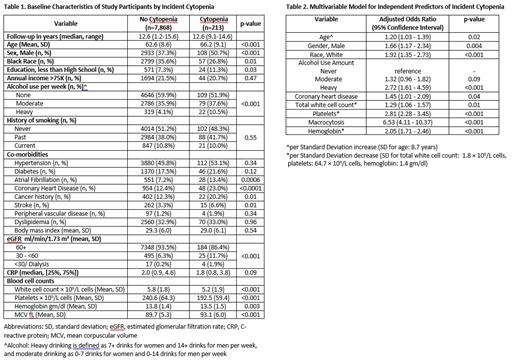Abstract
INTRODUCTION: Cytopenia, defined as low counts in 2 or more blood cell lines is commonly associated with nutritional deficiencies, medications and chronic inflammation. In some individuals, cytopenia may reflect a pre-malignant condition or precursor of hematologic cancer. We recently demonstrated that cytopenia is associated with increased risk of mortality and was predictive of stroke risk in Black individuals (Blacks). In the current study, we sought to determine the sociodemographic and clinical characteristics associated with incident cytopenia in a large biracial prospective study, REasons for Geographic and Racial Differences in Stroke (REGARDS).
METHODS: The REGARDS study recruited 30,239 Black and White individuals ≥45 years in the United States (US) between 2003 and 2007 (44% Black, ~50% females, 56% living in the southeast US). Socio-demographics and medical history were obtained by telephone interview and self-administered questionnaires, and laboratory studies (including complete blood count [CBC]) from an in-home visit at baseline and at a 10 year follow up visit. Cytopenia was defined as presence of 2 or more of the following: i) Hemoglobin in age-, sex-, and race-specific ≤5th percentile; ii) White cell count in race-specific ≤5th percentile; iii) Platelet count in ≤5th percentile, and iv) Macrocytosis (mean corpuscular volume [MCV] >98fL), due to known differences in CBC based on these demographic characteristics. We excluded participants without CBC at study enrollment and at the 2nd follow up visit, those who had cytopenia at baseline or died before the 10 year follow up visit, yielding an analytic sample of 8,081 participants. Baseline characteristics of those with or without incident cytopenia were tabulated and compared using Chi-Square tests or t-tests. Multivariable logistic regression using a purposeful selection algorithm was performed to identify factors independently associated with incident cytopenia.
RESULTS: Incident cytopenia occurred in 213 of 8,081 (2.6%) participants, with the highest incidence in White men ≥65 years (4.6%) and the lowest incidence in Black women <65 years (1.0%). Baseline factors univariately associated with cytopenia are shown in Table 1. The purposeful selection algorithm yielded a multivariable model including the following factors associated with incident cytopenia: older age, male sex, White race, heavy alcohol intake, coronary heart disease, abnormal blood counts at baseline visit including lower white count, lower platelet count, lower hemoglobin and high MCV (all p<0.05) (Table 2). The area under the receiver operating characteristic curve for this model was 0.81.
CONCLUSION: In this large biracial cohort, the incidence of cytopenia was 2.6% over 10 years. Adjusting for baseline blood counts, risk factors for cytopenia included older age, male sex, White race, heavy alcohol intake and coronary heart disease. Baseline blood counts were also important predictors. This study provides valuable insights into the pattern of abnormal blood counts and the sociodemographic and clinical characteristics associated with incident cytopenia. Research is ongoing to define the cause(s) of cytopenia including the role of clonal mutations in the peripheral blood of this population.
Gangaraju: Alexion: Consultancy; Sanofi Genzyme: Consultancy.


